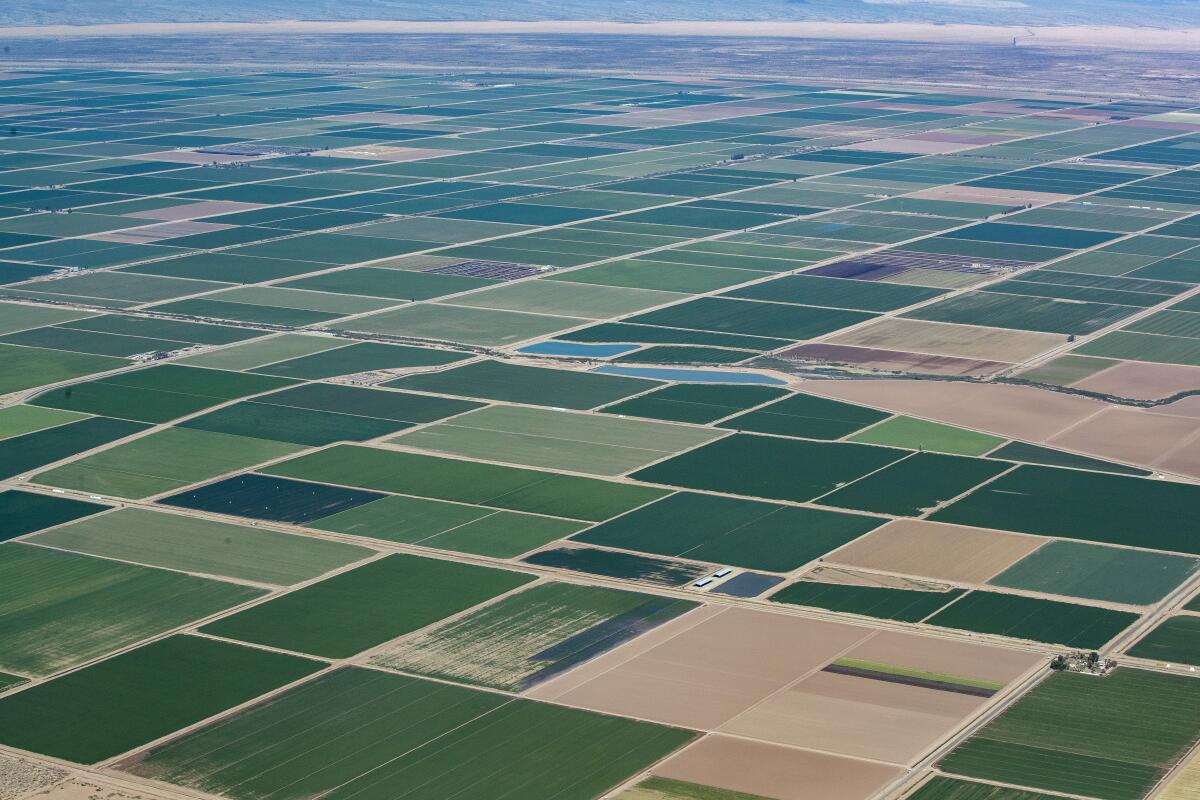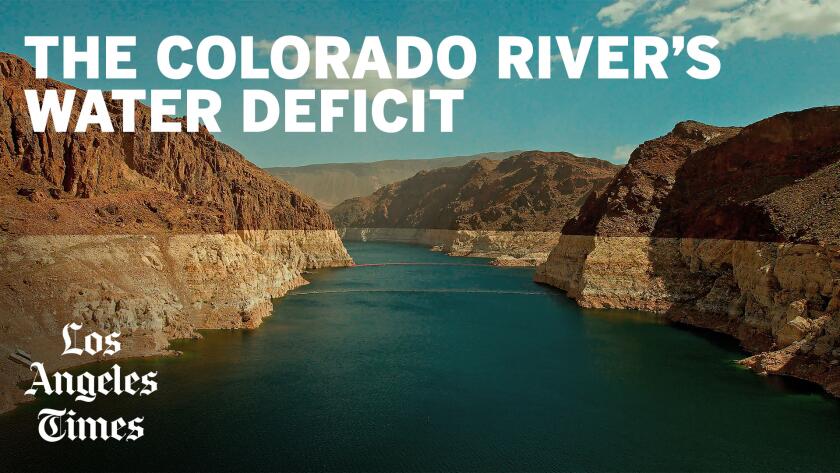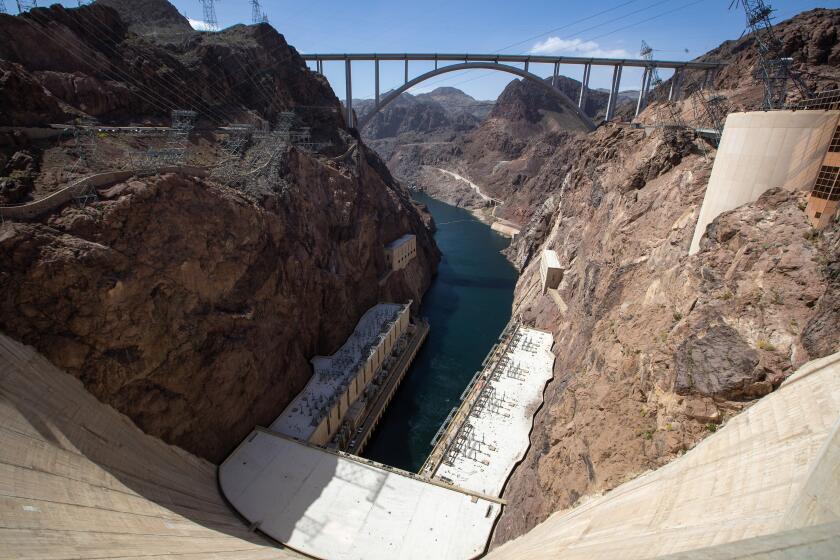Despite deal, Colorado River’s long-term water crisis remains unsolved

- Share via
A proposed deal for California, Arizona and Nevada to take less water from the over-tapped Colorado River depends heavily on $1.2 billion in federal funds, which will pay farmers and others who agree to give up some of their supply over the next three years.
But that infusion of federal money, made available through the Inflation Reduction Act, will facilitate the cutbacks only temporarily. Experts say much larger reductions will be needed in the coming years to close the gap between water supply and demand, and to adapt to diminishing flows due to climate change.
The agreement, which has yet to be approved, offers a stopgap solution to prevent reservoirs from reaching critically low levels, while leaving the region’s water managers with difficult questions to resolve when they negotiate a long-term plan for reducing use after 2026.
“We have a horrible math problem that needs to be solved,” said Mark Gold, director of water scarcity solutions for the Natural Resources Defense Council. “States are taking more water out than there is water in the river.”
Under the agreement announced this week, the three states committed to reducing water use by 3 million acre-feet between now and the end of 2026 — an average of 1 million acre-feet per year.
Federal officials, who will analyze the proposal, had been weighing options involving bigger reductions of 2 million acre-feet per year, which would shrink water use in the three states by about 29%.
But with heavy snow blanketing the Rocky Mountains and reservoirs set to rise, officials representing water agencies offered smaller cuts that they have calculated will be sufficient through 2026, when the proposed deal would expire.
Gold urged the Biden administration to put the larger cutbacks in place.
“The Colorado River Basin is in crisis,” he said.
If federal officials accept the proposal from the states, he said, it will delay major decisions on long-term reductions until the more difficult negotiations on a post-2026 plan.
Los Angeles Times reporter Ian James visits Lake Mead, Hoover Dam and farming areas in Southern California on a tour with managers of the Metropolitan Water District. Leaders of water agencies that supply cities and farms are discussing ways of reducing water use to address the river’s crisis.
Another concern, Gold said, is that the states’ proposal would spend more than $1 billion on temporary cutbacks, largely by paying agricultural landowners to leave fields fallow, rather than investing in permanent water-saving solutions on farms and in cities.
“Federal infrastructure dollars should not simply compensate agribusinesses to fallow some of their lands, an action that provides fleeting conservation benefits, with all of the money benefiting landowners and none of it benefiting the farmworkers and communities who will be affected,” Gold said. “A better approach would be to use federal infrastructure dollars to support permanent improvements that result in sustainable urban and agricultural water savings.”
Seven states have agreed to cut water use to boost the Colorado River’s depleted reservoirs, reaching a consensus after months of negotiations.
Gold said such actions could include requiring more efficient irrigation systems for agriculture, converting grass to native landscaping in cities and building water recycling facilities.
Gold and other experts called the proposed deal a Band-Aid for a long-term problem.
The federal money supporting the fallowing of farmland functions “like a painkiller,” said Newsha Ajami, chief development officer for research at the Earth and Environmental Sciences Area at the Lawrence Berkeley National Laboratory.
“It sort of relieves us from the pain we were experiencing by having some people not use their water, but is it a permanent change? Not really,” Ajami said. “Is it going to solve our problem? Not really. You’re just kicking the can down the road, hoping for the best.”
Paying farmers to conserve water might make sense politically, but the $1.2 billion would be better spent on water projects to help the states become less reliant on the Colorado River permanently, said David Zilberman, a professor of agricultural and resource economics at UC Berkeley.
“My feeling is, if you really want to solve the water problem, and you have money, use it to increase our resources,” Zilberman said.
The long-depleted Colorado River is getting a boost from the largest snowpack since 1997. Rising reservoirs offer some relief amid talks on needed water cuts.
That could include investments in water recycling and desalination, he said, and efforts to improve drainage, treat contaminated water and enhance the quality of aquifers.
“This is a time to take advantage of our creativity and our imagination and our technology to totally manage our plumbing,” Zilberman said. “It’s like when it comes to a house — when you do remodeling, it’s better to do a complete remodeling rather than to have some patches, and in the meantime, all the contractors and all the other people make money. We can develop a system that really will be better for society.”
The deal will buy time until the next round of negotiations, which will likely be contentious, said Michael Cohen, a senior researcher with the Pacific Institute.
“Anybody who pays attention to climate change knows that the trend for the river is lower and lower, and that the cuts proposed here are not nearly enough to keep pace with that declining inflow,” Cohen said.
The proposal includes cuts in the Colorado River lower-basin states of California, Arizona and Nevada, while there are no commitments of additional reductions by the upper-basin states: Colorado, Utah, Wyoming and New Mexico. While the seven states signed a letter supporting the proposal, tensions remain in the region, Cohen said.
“Really, the bridging that occurred here is between California and Arizona and Nevada, but not with the basin as a whole,” he said.
Managers of water agencies who were involved in the negotiations said having an agreement in place will address the immediate risks and boost reservoir levels, while allowing them to turn their attention to decisions about long-term management and negotiating the rules for apportioning reductions after 2026.
The proposed deal represents “incremental adaptation” and a step in the right direction, said Dave White, a professor at Arizona State University who leads the Arizona Water Innovation Initiative.
“It gives the states an opportunity as we manage the short-term risks to begin to pivot and think about more structural, more transformative adaptations,” White said. “We need a more transformative adaptation over the next several years.”
Colorado River in Crisis is a series of stories, videos and podcasts in which Los Angeles Times journalists travel throughout the river’s watershed, from the headwaters in the Rocky Mountains to the river’s dry delta in Mexico.
He said the region needs to find a sustainable financial approach to achieving substantially larger cuts of about 3 million acre-feet a year, because the $1.2 billion that’s available from the federal government will be used up.
Under the states’ plan, 2.3 million acre-feet in reductions would come in exchange for compensation, which works out to more than $500 per acre-foot. (An acre-foot is enough water to supply three typical Southern California households for a year.)
In October, the federal Interior Department announced a program inviting agricultural water districts and other applicants to submit proposals for reducing use, offering payments between $330 and $400 per acre-foot. The details of the compensation have yet to be announced.
“It’s certainly not a long term, sustainable financial model to compensate voluntary conservation at that level,” White said.
Roughly 80% of the water diverted from the river is used for agriculture, irrigating alfalfa and other cattle-feed crops, as well as a variety of vegetables, from lettuce to carrots.
“We need to be having sustained conversations about how we transition to a more sustainable agricultural sector,” White said. Doing that may require new agreements, incentives and regulations, he said, to prioritize high-value crops while transitioning away from lower-value feed crops.
In the meantime, managers of agricultural irrigation districts in California and Arizona have applied for federal funding to compensate farmers for growing less and leaving some of their water in Lake Mead, the nation’s largest reservoir, which is now 30% full.
Some growers say they are prepared to forgo summer crops, such as hay or wheat, and fallow fields for part of the year in exchange for payment.
Gold said that in addition to money for agricultural landowners, funds should be made available to provide opportunities to farmworkers who are vulnerable to job losses when fields are left dry.
Tribes are also seeking to be involved in contributing to reductions. Federal officials have announced that $233 million will go to Arizona’s Gila River Indian Community, much of it to compensate the tribal nation for leaving water in Lake Mead.
The Quechan Tribe of the Fort Yuma Indian Reservation has also submitted a proposal to the federal government to participate in conserving Lake Mead, said Jay Weiner, a water lawyer for the tribe. The tribe has participated in a voluntary program in which farmers don’t grow crops on some of their land from April through July.
“We’re not reinventing the wheel here. It’s just that we’ve got to get these agreements in place and identify what the funding levels are going to be and how the mechanics are going to work,” Weiner said.
The tribe’s leaders offered input that contributed to the agreement among the states, Weiner said, and the consensus has moved the region on a path toward collaboration and away from litigation.
“I don’t think anyone is under any illusions that the lower-basin states’ consensus is going to fix the problem on the river. It does not address the ongoing structural deficit. It is not a long-term solution,” Weiner said. “But coupled with the favorable hydrology that this past winter brought us, it allows us to really roll up our sleeves and sit down and try to figure out what the longer-term solutions might be, which are going to require very difficult conversations.”












